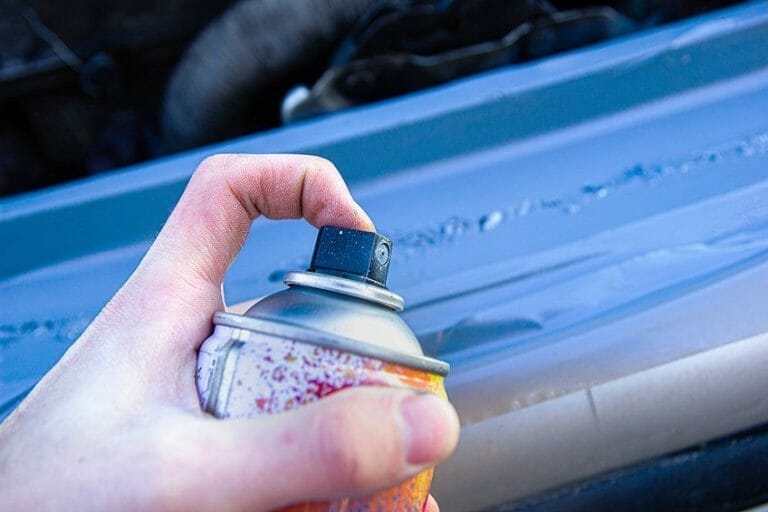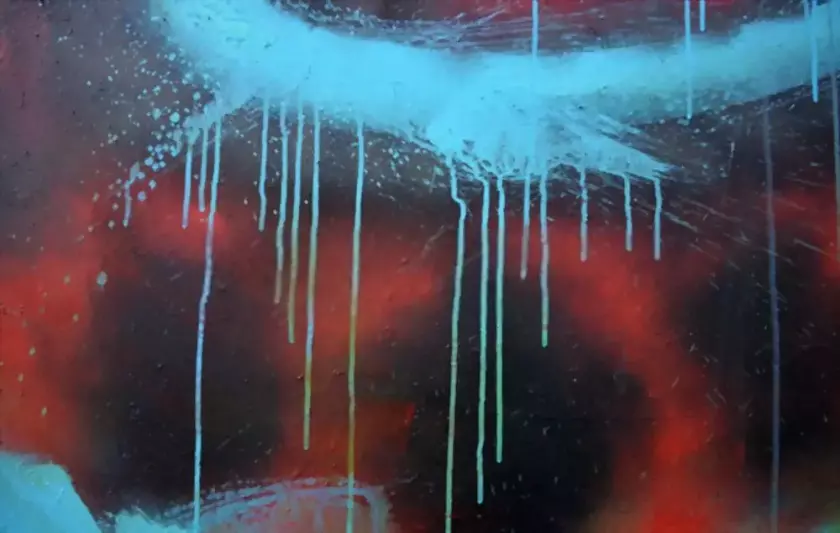Spray paint is a popular choice for giving a fresh look to various surfaces. But what happens when you need to spray paint in cold weather? Well, the temperature can significantly affect the drying process of spray paint. In colder temperatures, the paint takes much longer to dry, leading to potential issues like running or smudging.
When spray painting in cold weather, it is crucial to consider the specific instructions provided by the paint manufacturer. They often recommend an ideal temperature range for optimal drying. Additionally, using a quality spray paint designed for cold weather conditions can help ensure better adhesion and a smoother finish.
It’s also essential to prepare the surface properly before spray painting in cold weather. Make sure it is clean and dry to encourage better paint adherence. Furthermore, it may be beneficial to work in a well-ventilated area or wear a mask to avoid inhaling fumes.
Patience is key when spray painting in cold weather. Allow ample time for each coat to dry thoroughly before applying the next one. It’s advisable to wait for a warmer day if the temperature is too low, as it can greatly affect the quality and durability of the spray-painted surface.
In conclusion, while it is possible to spray paint in cold weather, it requires careful consideration and attention to detail. Adhering to the manufacturer’s instructions, using suitable cold weather spray paint, and taking necessary precautions will ensure a successful paint job, even

Tips to Make Spray Paint Dry Faster in Cold Temperatures
When it comes to spray painting, temperature plays a crucial role in the drying process. Cold temperatures can significantly slow down the drying time of spray paint, which can be frustrating when you’re working on a project. However, there are a few tips and tricks you can use to help speed up the drying time and achieve better results when spray painting in cold temperatures.
1. Choose the Right Paint
Not all spray paints are created equal, and some are specifically designed to dry faster in colder temperatures. Look for spray paint brands that offer formulas optimized for low-temperature applications. These paints contain additives or solvents that help them dry more quickly, even in cold weather.
2. Warm Up the Surface
Before you start spray painting, it’s essential to warm up the surface you’ll be painting on. Cold surfaces can absorb heat from the paint, causing it to take longer to dry. Use a heat gun or a hairdryer on a low setting to gently warm up the surface. This will help the paint adhere better and dry faster.
3. Increase the Ambient Temperature
If possible, try to increase the ambient temperature of the area where you’ll be spray painting. You can achieve this by using portable heaters or working in a warmer room. Warmer temperatures help the paint particles evaporate faster, leading to quicker drying times.
4. Use a Thinner Coat
In colder temperatures, it’s best to apply thinner coats of paint. Thick layers take longer to dry, and the cold weather can make it even more challenging for the paint to cure. Apply multiple thin coats instead of one thick coat, allowing each layer to dry before applying the next. This will help speed up the overall drying process.
5. Keep the Spray Can Warm
Cold temperatures can also affect the spray can itself, causing the paint to come out in an uneven or inconsistent manner. To prevent this, keep the spray can warm by placing it in warm water for a few minutes before use. This will help the paint flow smoothly and evenly onto the surface.
6. Use a Drying Accelerator
If you’re in a hurry and need the paint to dry as quickly as possible, consider using a drying accelerator. There are various drying accelerator products available that can help speed up the drying time of spray paint. Follow the instructions on the product carefully to ensure proper usage.
7. Allow for Adequate Drying Time
While these tips can help expedite the drying process, it’s still essential to allow for adequate drying time. Even with the use of drying accelerators and other techniques, cold temperatures can prolong the drying process. Be patient and give the paint enough time to fully dry and cure before handling or applying additional layers.
Summary
Spray painting in cold temperatures can be challenging, but with the right approach, you can speed up the drying time and achieve optimal results. Choose a spray paint specifically designed for low-temperature applications, warm up the surface before painting, and increase the ambient temperature if possible. Apply thinner coats, keep the spray can warm, and consider using a drying accelerator when necessary. Remember to allow for adequate drying time to ensure a durable and professional-looking finish.

Best Techniques for Applying Spray Paint in Cold Weather
When it comes to painting in cold weather, there are a few challenges that can arise. Cold temperatures can affect the performance and drying time of spray paint, leading to uneven finishes and longer drying times. However, with the right techniques, you can still achieve professional-looking results even in cold weather conditions. In this section, we will discuss the best techniques for applying spray paint in cold weather.
1. Choose the Right Temperature
Before you start painting, it’s important to check the temperature range recommended by the manufacturer of the spray paint. Most spray paints have a minimum and maximum temperature range in which they should be applied. Make sure the temperature is within this range to ensure optimal results. If the temperature is too cold, the paint may not adhere properly, and if it’s too warm, the paint may dry too quickly.
2. Prepare the Surface
Proper surface preparation is crucial for a successful paint job, especially in cold weather. Clean the surface thoroughly to remove dust, dirt, and grease. Use a mild detergent or a surface cleaner specifically designed for the material you are painting. Allow the surface to dry completely before applying the spray paint.
3. Warm Up the Paint
In cold weather, spray paint can become thicker and harder to work with. To make the paint more manageable, warm it up before use. Place the can of spray paint in a bucket filled with warm water for around 10 minutes. This will help to reduce the viscosity of the paint and make it easier to spray evenly.
4. Shake the Can Thoroughly
Before using spray paint, it’s important to shake the can thoroughly. This will ensure that the paint is well-mixed and that the color is evenly distributed. In cold weather, the paint may separate and settle at the bottom of the can more quickly. So, give it a good shake for at least a minute to ensure a consistent finish.
5. Apply Thin Coats
In cold weather, it’s best to apply multiple thin coats of spray paint rather than one thick coat. Thin coats dry faster and are less likely to run or sag. Hold the can about 8-12 inches away from the surface and spray using quick, sweeping motions. Allow each coat to dry according to the manufacturer’s instructions before applying the next one.
6. Work in a Well-Ventilated Area
Regardless of the weather, it’s important to work in a well-ventilated area when using spray paint. Cold weather can make it tempting to work indoors, but this can lead to the accumulation of fumes and decrease air quality. Choose a well-ventilated area, such as a garage with the doors open or an outdoor space, to ensure proper ventilation while painting.
7. Protect Against Overspray
Overspray can be more noticeable in cold weather due to slower evaporation rates. To protect surrounding surfaces from overspray, use drop cloths, plastic sheets, or masking tape and paper to cover areas that you don’t want to be painted. This will help maintain a clean and professional-looking finish.
8. Allow for Sufficient Drying Time
Cold temperatures can extend the drying time of spray paint. It’s important to allow each coat to dry completely before applying additional coats or handling the painted surface. Check the manufacturer’s instructions for the recommended drying time and ensure that the paint is fully dry before moving or touching the painted object.
In summary, painting with spray paint in cold weather may require some adjustments and extra precautions, but it is still possible to achieve excellent results. By choosing the right temperature, preparing the surface properly, warming up the paint, applying thin coats, working in a well-ventilated area, protecting against overspray, and allowing for sufficient drying time, you can overcome the challenges of cold weather and achieve a professional finish.

Common Mistakes to Avoid When Using Spray Paint in Cold Conditions
Using spray paint in cold conditions can present some challenges, as low temperatures can affect the drying process and overall quality of the finish. To ensure successful results, it’s important to avoid certain common mistakes. Below are some of the most common mistakes people make when using spray paint in cold conditions, along with tips on how to avoid them:
Lack of Proper Surface Preparation
One of the most crucial steps in any spray painting project is proper surface preparation. In cold weather, it’s even more important to thoroughly clean and dry the surface you plan to paint. Moisture and contaminants can negatively affect the adhesion and finish of the paint. Make sure to remove any dirt, grease, or rust using appropriate cleaning agents and tools. Additionally, ensure that the surface is completely dry before applying the paint.
Not Using a Primer
In colder temperatures, using a primer is essential to achieve good adhesion and durability of the paint. Primer helps to create a uniform surface and improves the paint’s ability to bond with the substrate. Choose a primer that is suitable for the specific material you are painting, such as metal or wood. Apply a thin, even coat of primer and allow it to dry completely before proceeding with the topcoat.
Ignoring Temperature Guidelines
Most spray paints have specific temperature guidelines for optimal performance. Ignoring these guidelines can result in poor adhesion, uneven drying, and other issues. It’s important to check the manufacturer’s instructions and make sure the ambient temperature and surface temperature are within the recommended range. If the temperature is too low, consider using a paint specifically formulated for cold weather application.
Applying Too Thick or Too Thin Coats
When using spray paint in cold conditions, it can be tempting to apply thicker coats in order to speed up the drying process. However, this can lead to sagging, running, and an uneven finish. On the other hand, applying thin coats may not provide enough coverage and can result in a weak, patchy finish. It’s important to follow the recommended number of coats and apply them in thin, even layers. This allows each coat to dry properly and ensures a smooth and durable finish.
Rushing the Drying Process
In cold conditions, the drying time for spray paint can be longer than usual. It’s crucial to be patient and allow each coat to dry fully before applying the next one or handling the painted surface. Rushing the drying process can lead to smudging, smearing, or damage to the freshly painted surface. Follow the manufacturer’s instructions for drying times and, if necessary, provide additional time for the paint to cure before subjecting it to any stress or contact.
Not Protecting the Surrounding Area
Spray painting can create overspray, which can settle on nearby surfaces and cause unwanted paint splatters or stains. It’s important to protect the surrounding area by using drop cloths, plastic sheets, or masking tape to cover any surfaces that should not be painted. This will help prevent accidental damage and make the cleanup process much easier.
In summary, when using spray paint in cold conditions, it’s crucial to properly prepare the surface, use a primer, follow temperature guidelines, apply thin and even coats, allow for sufficient drying time, and protect the surrounding area. By avoiding these common mistakes and taking the necessary precautions, you can achieve professional-looking results even in chilly weather.
How to Properly Store Spray Paint in Chilly Weather to Prevent Drying Issues
When the temperature drops during the chilly winter months, it is essential to take extra precautions when storing spray paint. Cold weather can cause spray paint to thicken or even dry out, rendering it unusable. To ensure the longevity and effectiveness of your spray paint, follow these guidelines for proper storage in chilly weather:
1. Choose a Suitable Storage Location
Find a storage location that maintains a relatively stable temperature, preferably above freezing. Ideal storage locations include a heated garage, a climate-controlled storage unit, or an insulated shed. Avoid storing spray paint in areas exposed to extreme temperature fluctuations, such as an uninsulated attic or an unheated basement.
2. Seal the Cans Properly
Prior to storing, make sure the spray paint cans are tightly sealed to prevent air from entering. Air exposure can cause the paint to thicken or dry out. Check the cans for any leaks or damaged seals, and discard any cans that are not properly sealed.
3. Keep the Spray Paint at Room Temperature
Before storing the spray paint, allow it to reach room temperature. Cold paint is more prone to clumping and drying out. Keep the paint indoors for a few hours to warm up before placing it in storage.
4. Avoid Extreme Temperature Fluctuations
Protect the spray paint from rapid temperature changes, as this can affect its consistency and quality. Avoid storing the paint near heating sources, such as radiators or heaters, as the sudden heat can cause the cans to expand and potentially burst. Similarly, keep the paint away from freezing temperatures, as this can cause the paint to thicken or separate.
5. Store the Spray Paint Upright
When storing spray paint cans, always keep them upright. Storing them on their sides or upside down can lead to the paint drying out or clogging the nozzle. Additionally, storing the cans upright ensures that the paint settles evenly inside the can, preventing any separation or clumping.
6. Rotate the Spray Paint Inventory
Regularly check the expiration dates on your spray paint cans and rotate your inventory. Use the older cans first to ensure that they are still in good condition and have not dried out. By using the oldest cans first, you can avoid wasting paint that may no longer be usable.
7. Insulate the Storage Space
If your storage location is prone to colder temperatures, consider insulating the area to help maintain a more constant temperature. Insulation can help prevent extreme fluctuations and provide a more stable environment for your spray paint.
8. Avoid Direct Sunlight
Do not store spray paint in direct sunlight or near windows. Heat from the sun can cause the cans to become excessively hot, potentially altering the paint’s consistency and quality. Choose a shaded area or a storage space away from direct sunlight.
9. Test the Spray Paint Before Use
Prior to using the spray paint, conduct a quick test on a scrap surface to ensure it is still in good condition. Spray a small amount to check the consistency and color. If the paint appears clumpy or uneven, discard the can and use a fresh one.
In summary, proper storage of spray paint in chilly weather is crucial to prevent drying issues. Choose a suitable storage location with a stable temperature, seal the cans tightly, keep the paint at room temperature, avoid extreme temperature fluctuations, store the cans upright, rotate the inventory, insulate the storage space if necessary, avoid direct sunlight, and test the paint before use. By following these guidelines, you can ensure that your spray paint remains in optimal condition even in chilly weather.
FAQs
Will spray paint dry in cold weather?
Yes, spray paint can dry in cold weather, but it may take longer than it would in warmer temperatures. Cold temperatures can slow down the drying process, so it is recommended to allow for additional drying time and ensure proper ventilation to help the paint dry more effectively.
Conclusion
In conclusion, the drying process of spray paint in cold weather can be significantly affected. The colder temperatures slow down the evaporation of solvents in the paint, leading to a longer drying time. This can result in a poor finish and potential damage to the painted surface. It is advisable to avoid spraying paint in extremely cold conditions to ensure optimal drying and a professional-looking outcome.
However, there are certain measures you can take to speed up the drying process in cold weather. Keeping the painted object in a warm and well-ventilated area, using a heat source or using paint specifically formulated for cold-weather application can all help speed up the drying time. It is always important to follow the manufacturer’s guidelines for the specific spray paint product you are using.
Ultimately, patience and careful consideration of the weather conditions are key when spray painting in cold weather. By taking necessary precautions, you can achieve a successful and durable finish even in less than ideal temperatures.
